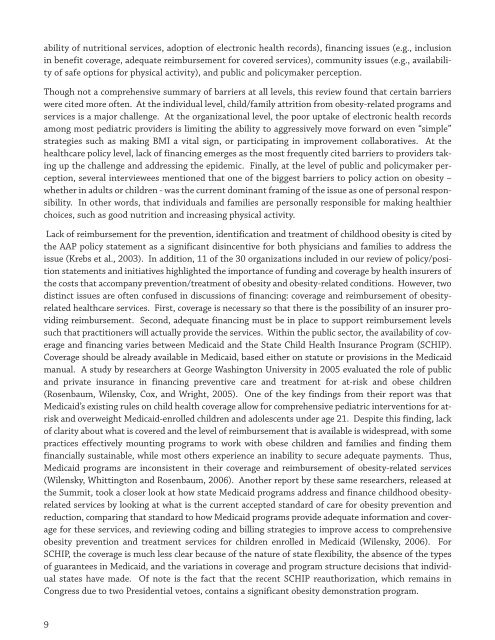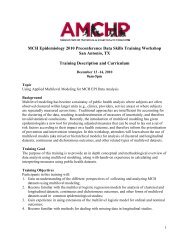Childhood Obesity: The Role of Health Policy - Association of ...
Childhood Obesity: The Role of Health Policy - Association of ...
Childhood Obesity: The Role of Health Policy - Association of ...
Create successful ePaper yourself
Turn your PDF publications into a flip-book with our unique Google optimized e-Paper software.
ability <strong>of</strong> nutritional services, adoption <strong>of</strong> electronic health records), financing issues (e.g., inclusion<br />
in benefit coverage, adequate reimbursement for covered services), community issues (e.g., availability<br />
<strong>of</strong> safe options for physical activity), and public and policymaker perception.<br />
Though not a comprehensive summary <strong>of</strong> barriers at all levels, this review found that certain barriers<br />
were cited more <strong>of</strong>ten. At the individual level, child/family attrition from obesity-related programs and<br />
services is a major challenge. At the organizational level, the poor uptake <strong>of</strong> electronic health records<br />
among most pediatric providers is limiting the ability to aggressively move forward on even “simple”<br />
strategies such as making BMI a vital sign, or participating in improvement collaboratives. At the<br />
healthcare policy level, lack <strong>of</strong> financing emerges as the most frequently cited barriers to providers taking<br />
up the challenge and addressing the epidemic. Finally, at the level <strong>of</strong> public and policymaker perception,<br />
several interviewees mentioned that one <strong>of</strong> the biggest barriers to policy action on obesity –<br />
whether in adults or children - was the current dominant framing <strong>of</strong> the issue as one <strong>of</strong> personal responsibility.<br />
In other words, that individuals and families are personally responsible for making healthier<br />
choices, such as good nutrition and increasing physical activity.<br />
Lack <strong>of</strong> reimbursement for the prevention, identification and treatment <strong>of</strong> childhood obesity is cited by<br />
the AAP policy statement as a significant disincentive for both physicians and families to address the<br />
issue (Krebs et al., 2003). In addition, 11 <strong>of</strong> the 30 organizations included in our review <strong>of</strong> policy/position<br />
statements and initiatives highlighted the importance <strong>of</strong> funding and coverage by health insurers <strong>of</strong><br />
the costs that accompany prevention/treatment <strong>of</strong> obesity and obesity-related conditions. However, two<br />
distinct issues are <strong>of</strong>ten confused in discussions <strong>of</strong> financing: coverage and reimbursement <strong>of</strong> obesityrelated<br />
healthcare services. First, coverage is necessary so that there is the possibility <strong>of</strong> an insurer providing<br />
reimbursement. Second, adequate financing must be in place to support reimbursement levels<br />
such that practitioners will actually provide the services. Within the public sector, the availability <strong>of</strong> coverage<br />
and financing varies between Medicaid and the State Child <strong>Health</strong> Insurance Program (SCHIP).<br />
Coverage should be already available in Medicaid, based either on statute or provisions in the Medicaid<br />
manual. A study by researchers at George Washington University in 2005 evaluated the role <strong>of</strong> public<br />
and private insurance in financing preventive care and treatment for at-risk and obese children<br />
(Rosenbaum, Wilensky, Cox, and Wright, 2005). One <strong>of</strong> the key findings from their report was that<br />
Medicaid’s existing rules on child health coverage allow for comprehensive pediatric interventions for atrisk<br />
and overweight Medicaid-enrolled children and adolescents under age 21. Despite this finding, lack<br />
<strong>of</strong> clarity about what is covered and the level <strong>of</strong> reimbursement that is available is widespread, with some<br />
practices effectively mounting programs to work with obese children and families and finding them<br />
financially sustainable, while most others experience an inability to secure adequate payments. Thus,<br />
Medicaid programs are inconsistent in their coverage and reimbursement <strong>of</strong> obesity-related services<br />
(Wilensky, Whittington and Rosenbaum, 2006). Another report by these same researchers, released at<br />
the Summit, took a closer look at how state Medicaid programs address and finance childhood obesityrelated<br />
services by looking at what is the current accepted standard <strong>of</strong> care for obesity prevention and<br />
reduction, comparing that standard to how Medicaid programs provide adequate information and coverage<br />
for these services, and reviewing coding and billing strategies to improve access to comprehensive<br />
obesity prevention and treatment services for children enrolled in Medicaid (Wilensky, 2006). For<br />
SCHIP, the coverage is much less clear because <strong>of</strong> the nature <strong>of</strong> state flexibility, the absence <strong>of</strong> the types<br />
<strong>of</strong> guarantees in Medicaid, and the variations in coverage and program structure decisions that individual<br />
states have made. Of note is the fact that the recent SCHIP reauthorization, which remains in<br />
Congress due to two Presidential vetoes, contains a significant obesity demonstration program.<br />
9



